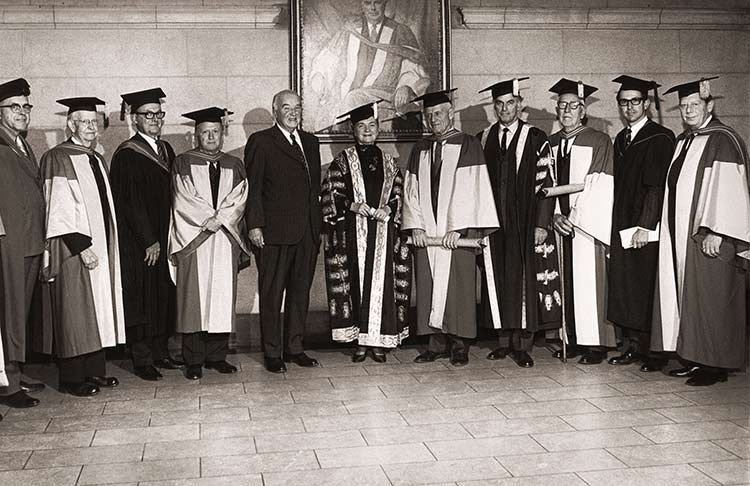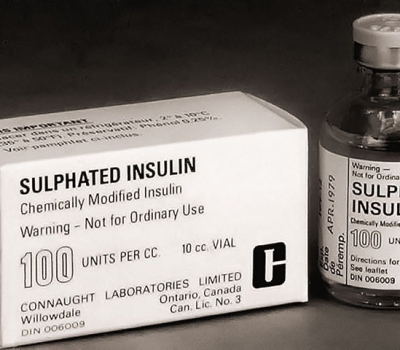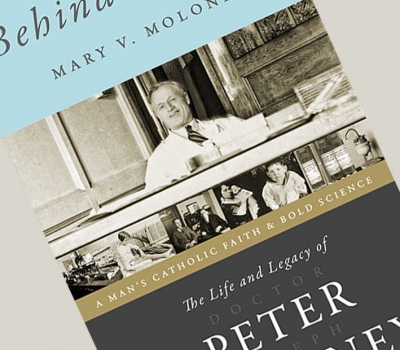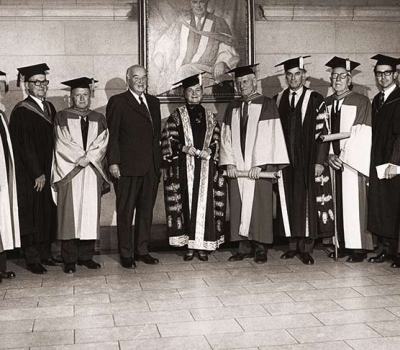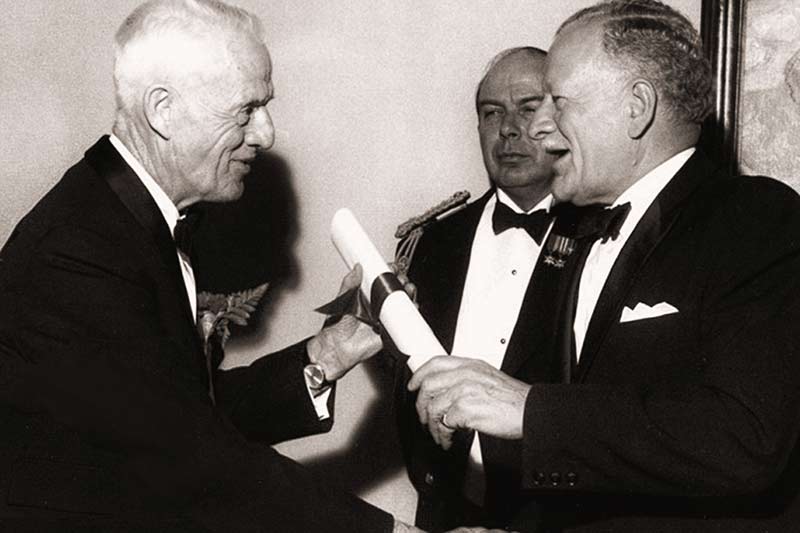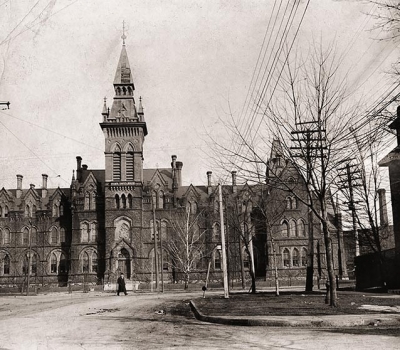On October 26, 1971, honorary degrees were conferred on seven medical scientists whose research had been concerned with insulin or related subjects including three from University of Toronto, one of whom was Dr. Peter Moloney.
University of Toronto Chancellor Pauline McGibbon and Dr. Charles H. Best stand next to him.
Details surrounding this event follow, including an excellent concise summary of Dr. Moloney's significant works, and the presentation address given for Dr. Moloney that evening.
U of T Insulin 50th Anniversary Celebrations - Some Further Details
When Dr. Frederick Banting and his student assistant Charles Best discovered insulin in 1921, they brought the prospect of early relief to more than one million people in North America alone who were known to be suffering from diabetes. But, while insulin, in one or other of its forms, can now control most forms of diabetes, medical scientists all over the world are still searching for ways to prevent or cure the disease and to deal with the many complications of diabetes.
An unparalleled opportunity for medical writers to hear about current research in the field of diabetes and other related metabolic conditions will occur during the week of October 25-30, when the University of Toronto celebrates the 50th Anniversary of the discovery of insulin made in a laboratory of its Medical School.
The occasion will bring to Toronto many great researchers. Among major events some of which have already been mentioned in earlier notices, there will be:
- A Three-day Symposium on Insulin Action, arranged by the Banting and Best Department of Medical Research for October 25-27. This will be attended by some 200 invited scientists from many parts of the world;
- A Two-Day Refresher Course for Physicians on Diabetes and its Control, which is being offered by the Division of Post-Graduate Medical Education in co-operation with the Canadian Diabetic Association, October 28-29. the content will also be suitable for nurses and dieticians involved in diabetic care.
- Lectures by six internationally known medical scientists, all recipients this year of the Gairdner Foundation Awards. These will be delivered on October 29-30 in the Medical Sciences Building. In addition to Dr. Charles Best, now professor emeritus of the Banting and Best Department of Medical Research, who co-discovered and initially directed the mass production of insulin, these award winners include Nobel Prize winner Dr. Frederick Sanger, head of the Protein Chemistry Division at Cambridge University; Dr. Rachmiel Levine, City of Hope Medical Center, Duarte, Calif.; Dr. Donald F. Steiner, Department of Biochemistry at the University of Chicago; and Drs. Solomon A. Berson and Rosalin F. Yalow, both of Mount Sinai Medical Centre, New York.
- An Exhibition of Paintings by the late Sir Frederick Banting in the nearby Toronto Academy of Medicine;
- The Unveiling of a Bust of Dr. Charles Best in the Memorial Lobby of the Medical Sciences Building;
- An Exhibition of Documents and Books, to be arranged by the Rare Books Department of the University of Torotno Library.
One of the other major events of the week, as already announced, will be a special convocation on the evening of October 26, at which honorary degrees will be conferred on seven medical scientists whose research has been concerned with insulin or related subjects. They are:
Dr. Robert Davies Defries of Toronto
Dr. Knud Hallas-Moller of Holts, Denmark
D. Maurice Edward Krahl of Stanford University, California
Dr. Peter Joseph Moloney of Toronto
Dr. David Alymer Scott of Toronto
Dr. George Ballard Walden of Indianapolis
Dr. Hans Christian Hagedorn of Gentofte, Denmark
Letter of Nomination for Honorary Doctorate:
Peter Joseph Moloney was born at Penetang, Ontario, and pursued his university studies at the University of Toronto from which institution he graduated with the degree Bachelor of Arts in 1912 in the Honour Course in Chemistry. Subsequently he obtained his Masters Degree also at the University of Toronto and, following a year in California, he returned to the University and studied for a Doctorate in chemistry which was awarded in 1924 for research studies conducted at the University in Connaught Laboratories. Apart from two early years as a chemist with the Canadian Department of Agriculture, Dr. Moloney's scientific life has been spent in the pursuit of various studies related to public health at Connaught Medical Research Laboratories. His particular interests there have been largely in the field of toxins, toxoids and anti-toxins. Much of the success of the preparation of diphtheria toxoids in Canada can be attributed directly to the work of Dr. Moloney and his associates. In later years these studies were extended to include other vaccines including combined vaccines such as diphtheria toxoid and pertussis vaccine. During the years of the last war the subject of the preparation of gas gangrene anti-toxin became one of considerable importance and was one of the subjects of interest to Dr. Moloney.
The discoveries related to penicillin provided a new area for biochemical investigation and Dr. Moloney worked in this field with outstanding success. In company with his associate, Dr. A. L. Tosoni, Dr. Moloney prepared crystallin penicillin by a new method in large quantities such that Connaught Laboratories was one of the first laboratories to offer crystalline penicillin for export. The process developed by Moloney and Tosoni for the crystallization of potassium penicillin continues to be used throughout the world.
At this time, however, our principal interest is in Dr. Moloney's activities related to insulin. As early as 1923 Dr. Moloney published three papers concerning methods for the concentration and purification of this newly discovered hormone. This work was conducted in association with D. M. Findlay. However, the principal series of investigations for which Dr. Moloney has world-wide fame in the insulin field concerns his discovery, first reported in 1955 in association with Mr. M. Goval, that insulin acts as an antigen in much the same manner as many other antigens such as toxoids and vaccines. It is fortunate however that the antigenic capacity of insulin is weak for, of course, the development of insulin antibodies in a diabetic patient is indeed an unfortunate event. This fundamental discovery of the antigenic nature of insulin has given rise to activities in other directions within the insulin field. For example, making use of the production of antibodies to insulin, Dr. Moloney has developed a method of assay which is now very widely used permitting the detection of very small amounts of insulin in blood and other fluids, by a method utilizing mouse diaphragm. But as with most fundamental scientific discoveries, the initial discovery has led to extensive work in other research laboratories. In consequence several other methods of assay for small amounts of insulin have been developed all based upon the observation that insulin is of an antigenic nature.
Dr. Moloney has investigated extensively the capacity of insulin from various species of animals to serve as an antigen. He has shown that there are marked differences in antigenicity between some insulin preparations, and this of course offers hope for the development of preparations which might be useful in the treatment of those few but unfortunate individuals who show antibodies to insulin administered to them to control the course of diabetes.
One of the preparations which arises from these studies is a product now distributed in Canada and some other parts of the world developed by Dr. Moloney and known as Sulphated Insulin. this product serves not only as a life sustaining preparation for some persons but also as a model to be pursued in devleoping other modified forms of insulin for treatment of diabetes.
But Dr. Moloney's activities in the University have not been confined to Connaught Medical Researhc Laboratories. He has been a member of the staff of the School of Hygiene terminating with his retirement as a professor in 1960. In his teaching activities Dr. Moloney endeared himself to his students as one who could present to them in an interesting, humorous and challenging manner many of the critical discussions which form a part of the studies of graduate students proceeding to a Diploma in Public Health. This presentation, although usually made in English, was made with facility in the French language to those students from French speaking areas of Canada or from countries abroad. It is surprising how much valuable discussion pertaining to the chlorination of water can be brought about with a cheap white teacup and a glass stirring rod!
Honours which have already been extended to Dr. Moloney are a tribute to the recognition which has been given to his work. In 1946 he was honoured by an award in the Order of the British Empire. In 1936 he was elected a fellow of the Royal Society of Canada. Having in mind his work related to diabetes and insulin, he was awarded the Banting medal on the occasion of the 5th Congress of the International Diabetes Federation meeting in Torotno in 1964. Also in that year the Charles Mickle Fellowship was awarded to Dr. Moloney. In 1967 he was one of the recipients of the Gairdner Awards.
It is a pleasure to suggest that the degree of Doctor of Laws be conferred upon Peter Joseph Moloney, a former Assistant Director of Connaught Medical Research Laboratories, a former professor in the School of Hygiene of the University of Toronto, a man of inquisitive mind and amusing wit who, though officially retired from the staff of the University of Toronto, continues to pursue new and interesting ideas in his laboratory and particularly in the fields of insulin and diabetes.
Address of Presentation of DR. PETER JOSEPH MOLONEY
for the degree of Doctor of Laws, honoris causa
Madam Chancellor:
It is rather exceptional, to present for the highest degree of the University of Toronto, a person who has achieved great distinction in the areas of both applied and basic science; and who many years after his official retirement continues to work in his laboratory challenging youth with imaginative ideas.
Peter Joseph Moloney was born in Penetang, a small community in Northern Ontario, at the turn of the century. After completing his secondary education at Powassan, where the family had moved, he enrolled at the University of Toronto as a student in St. Michael's College. He graduated with a Bachelor of Arts degree and also obtained his Masters in the Department of Chemistry at this University. Subsequently, having won a bursary, he spent a year in the Department of Physical Chemistry at the University of California.
However, longing for snow and cold winters, he returned to his native country bringing with him his newly acquired young bride from the south.
After a brief period with the Deparment of Agriculture in Ottawa, he joined the Connaught Medical Research Laboratories and the Department of Hygiene at the University of Toronto. Since then Moloney's scientific endeavours and studies became interlocked with the activities of these two institutions. He obtained his Ph. D. degree with work related to the purification of insulin from pancreatic extracts.
As a staff member now, his interests spread into immunological and immunochemical problems. As a result of his studies, vaccines and immuno-sera against diphtheria, whooping cough and tetanus have been improved and made much more effective. During the war he was instrumental in the preparation of antisera against gas-gangrene.
The discoveries related to penicillin provided a new area of investigation. With his associate, Dr. Tosoni, they developed a new method for the production of penicillin in large quantities. Connaught Medical Research Laboratories was one of the first laboratories to offer crystalline penicillin for export.
Moloney's mind did not distinuish between what is often called mission oriented and pure science. He could generate knowledge motivated by curiosity, or modify and use acquired knowledge for a specific task.
In 1955 Moloney and his students, discovered that insulin could, when properly injected into certain animals, give rise to highly specific antibodies. This discovery led to a series of important observations which stimulated investigations in many laboratories and permitted the development of precise methods to estimate protein hormones in health and disease.
During recent years Moloney has been actively engaged in modifying the molecule of insulin in order to make it effective in the treatment of diabetic patients who developed immunity against the hormone.
It is said, Madam Chancellor, that well endowed persons prove themselves early in life. Peter Moloney has also shown that the creative flame does not have to wither with the passing of the years. He kept it burning by his curiosity, his humour and his compassion. Madam Chancellor, I present to you, for the degree of Doctor of Laws, honoris causa, Peter Joseph Moloney, in inquisitve scientist, a witty teacher, a humble and sincere man.

